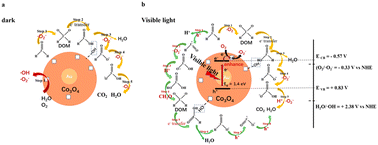Catalytic oxidation of formaldehyde over a Au@Co3O4 nanocomposite catalyst enhanced by visible light: moisture indispensability and reaction mechanism†
Abstract
Formaldehyde has strong carcinogenic and cancer-promoting effects, and its removal from indoor air is still challenging. Transition metal oxides such as cobalt(II,III) oxide (Co3O4) are potential catalysts to eliminate formaldehyde. However, the inherent low activity of Co3O4 at room temperature has greatly limited its utilization for indoor air purification. In this work, an extremely facile and mild method was designed to prepare a Au@Co3O4 core–shell nanocomposite catalyst, and its catalytic and photocatalytic activities for formaldehyde oxidation were determined both under dark conditions and visible-light irradiation. This material exhibited not only high catalytic formaldehyde oxidation efficiency in the absence of light but also significantly promoted photocatalytic formaldehyde oxidation activity under visible-light irradiation. Electron paramagnetic resonance and in situ diffuse reflectance infrared Fourier transform spectroscopy were applied to identify the reactive oxygen species and the produced degradation intermediates which adsorbed onto the surface of the catalyst during the oxidation process. It was found that the enhanced catalytic activity of the Au@Co3O4 nanocomposite catalyst under visible-light irradiation was mainly attributed to the promotion of oxygen and formaldehyde activation by the photogenerated carriers, facilitating the formation of dioxymethylene and thereby accelerating the key step of the generation of formic acid and carbonate species. This fundamental study provides evidence for a catalytic mechanism of the photocatalytic degradation of formaldehyde and a basis for the rational design of catalysts that efficiently eliminate indoor formaldehyde through full use of visible light.

- This article is part of the themed collection: Nanomaterials in air


 Please wait while we load your content...
Please wait while we load your content...